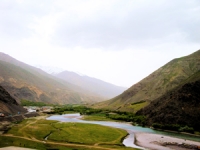Water sharing between Central Asian countries has been conflicting for quite a long time already.
Amu Darya River Basin

Geographical settings
The Amu Darya is the largest river in Central Asia, with a catchment area of 309 000 km2 and length 2540 km. It is a transboundary river shared by Afghanistan, Kyrgyzstan, Tajikistan, Turkmenistan, and Uzbekistan.
Most of the Amu Darya flow is formed on the territory of Tajikistan (72.8%), 14.6% in Afghanistan and 8.5% in Uzbekistan. Three major tributaries contribute to the river: Kafirnigan, Sherabad, and Surhandarya. The annual flow of the Amu Darya is 73.6 km3, with a storage capacity of 24 billion m3.
Almost eighty percent of the Amu Darya is regulated by over 35 reservoirs with a capacity of over 10 million m3[1]. Two main reservoirs, Nurek and Tuyamuyun, and several on-system reservoirs on the Karakum, Karshi and Amu-Bukhara canals operate on the main and small rivers.
Socio-economic settings
The Amu Darya river is important to the livelihoods of 43 million of people living in the Aral Sea Basin. The water resources are used mainly for agriculture, hydropower generation, industrial, domestic, and drinking purposes.
Agriculture is an important sector for the economies of riparian countries. Almost 80% of population in Afghanistan depends on agriculture for their livelihoods, and agriculture contributes to almost half of the GDP[2]. In other Central Asian countries, agriculture accounts for 20-30% of employment, and 20-35% contribution to GDP[3]. Agriculture is also the major water user in all the riparian countries, highest being Turkmenistan and Uzbekistan each taking about 42% of total water flow.
Institutional settings
At the interstate level, there are two main institutions responsible for transboundary water management in the Amu Darya basin:
The Interstate Commission for Water Coordination (ICWC), comprised of senior water officials from each riparian country, is responsible for water allocation, monitoring, and water use, and other issues in the region. The ICWC was established as a result of the Agreement signed by the Central Asian countries in 1992 on joint management of interstate water resources. The Basin water organization “Amu Darya”, the Scientific Information Center (SIC), and the ICWC Secretariat are the executing bodies of the ICWC. The Basin Water Organization “Amu Darya”, established in 1980s, is responsible for implementation of decisions on water allocation and distribution. The BWO is also responsible for operation and maintenance of all major water structures. TheSIC provides scientific and information support to the ICWC[4].
At regional level, the International Fund for Saving Aral Sea (IFAS) is an important institute serving as a platform for dialogue to improve cooperation between the countries on the efficient use and management of water resources, and improving socio-economic and environmental situation in the Aral Sea basin[5].
Issues in the Amu Darya river basin:
- Water pollution from agricultural, industrial, and municipal waste- and drainage waters;
- Heavy water loss (up to 40%) due to outdated irrigation canals loss;
- Previously agreed water allocation policies do not satisfy all the stakeholders’ interests, in particular irrigation versus hydropower generation
- Afghanistan, major contributor to the Amu Darya river flow, is not part of the legal or institutional framework;
- Awareness of climate change is not high.
Photo by Joelle Rizk




